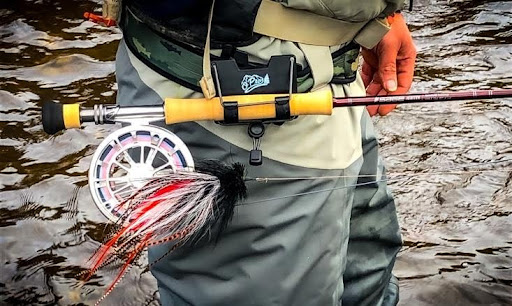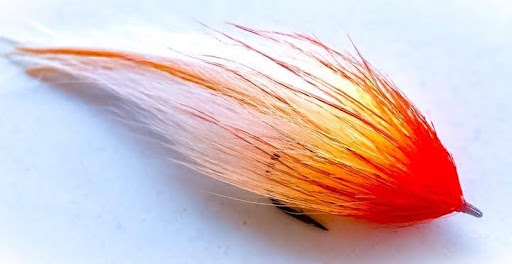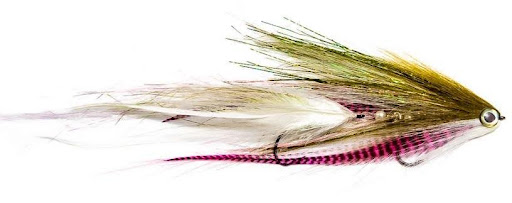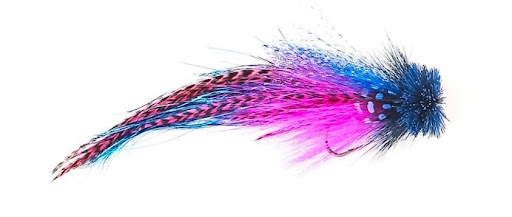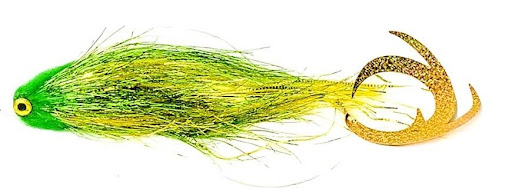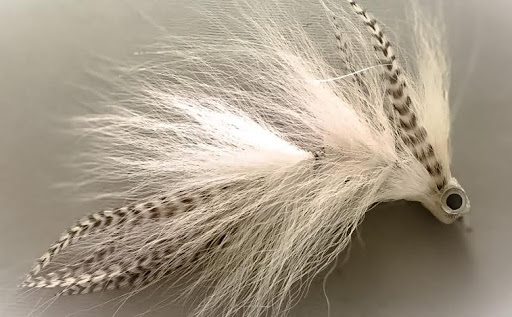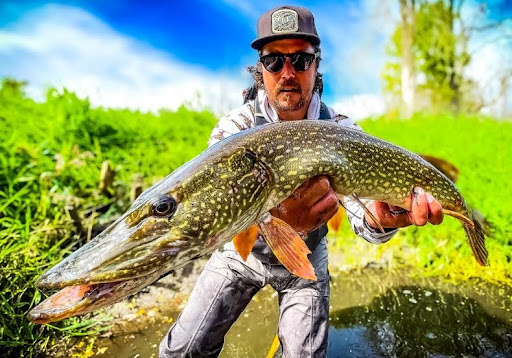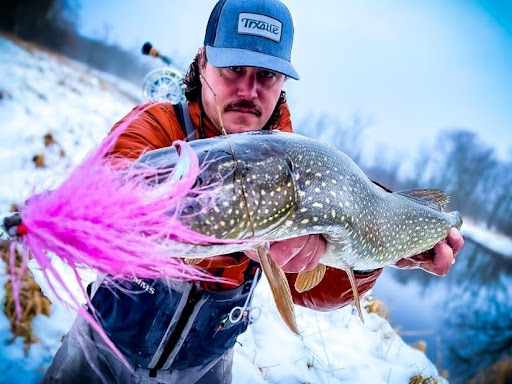Introduction
If you haven’t been fly fishing for Northern Pike with a fly rod, you are missing out on one of North America’s most amusing and exciting sport fish. The Esox lucius has light markings on a dark body and fewer than six sensory pores on the underside of each side of the lower jaw.
Pike are found in slow-moving rivers and shallow, weed lines in lakes, as well as in cold, clear, rocky waters. Typical ambush predators, they lie and wait for prey, holding perfectly still for long periods, and then exhibit remarkable acceleration as they strike. The lower half of the gill cover lacks scales, and it has large sensory pores on its head and on the underside of its lower jaw which are part of the lateral line system. Mean and aggressive, pike are eager to eat larger meals, and when a pike eats a fly, there will be no doubt as to what is on the end of your line… the takes are both ferocious and startling.
The Gear
When aiming to target northern pike, you will be using massive flies, delivering them on a faster action 8wt-10wt rod. This is not because you need such a stout rod to fight the pike once they are hooked, but to effectively and accurately cast these monstrous streamers. A 10wt is optimal and paired with an aggressive shooting head fly line this allows you to turn over large pike flies with relative ease. In regards to the cast, having an effective double-haul is essential to generate the line-speed required to shoot line as opposed to carrying line as you may fishing for trout.
As the mechanics of the double-haul are for another article, it is important to note that you are more interested in shooting line once you are in the sweet spot of the fly line, and, consequently, accelerating line-speed will put a deeper bend in the rod, thus allowing the rod to do the work, shooting line further with fewer false casts.
Sinking Lines
One thing that you will notice is that the majority of the flies used for fly fishing for northern pike are naturally buoyant (meaning extra weight such as lead wraps or lead eyes are rarely utilized), swimming anywhere from the first 3-12 inches of the water column. Certainly, in lower shallow waters of lakes or rivers, a floating line may be optimal. However, for most applications, a sink tip line is required to get the fly down further and swim deeper without compromising the desired movement designed into the fly.
Sink tips are essential to swimming these flies deeper in rivers as they generally have a 12-18ft, tungsten coated, sinking tip section and a floating head and running line. This not only prevents a downstream belly in the line (as opposed to a full sinking line) while allowing you to mend the line in order to stay tight to the fly. A 3ips (inches per second) sink tip is very versatile in a shallower river system while a more aggressive sink tip, 7ips may be more desirable in bigger river waterways or lakes where these fish may be even deeper.
Leader Setup
The optimal leader setup when fly fishing for northern pike is much different than most traditional tapered leaders that most fly anglers are familiar with. There are definitely premade predator leaders for sale that utilize knotable bite wire anywhere from 20-40lbs of breaking strength in order to prevent these toothy critters from easily tearing through monofilament or fluorocarbon.
However, building your own leader is astonishingly easy, creating a leader that is anywhere from 3.5-5.5ft long. A longer leader is not beneficial as pike are not leader shy and turning over these larger flies only gets more difficult as the leader gets longer. As a rule, a 4.5ft long leader is most advantageous for the widest variety of situations.
This pike leader is built by combining an approximately 3.5ft section of 15-30lbs fluorocarbon tippet (fluorocarbon has less stretch in it as compared to monofilament, making for a stronger hook set) and a 1ft section of 20-40lbs knotable bite wire. To make life easy on yourself, you can create a simple loop-to-loop connection with a perfection loop on the flouro and bite wire. Perfection loops are remarkably strong, however, it is essential to use similar diameters of flouro and bite wire to prevent breakage using a loop-to-loop connection. A more streamlined and equally strong tactic when fly fishing for northern pike is to connect the flouro to the bite wire using an albright knot. The albright is small, slim and very strong. Terminal knots are critical to attaching a fly to your leader, as you are looking to takeout anything that may fail like utilizing a metal clasp to attach your fly. Clasps are just one more thing to fail, and they do.
Using 20lbs knotable bite wire, using a 2 turn non-slip loop knot is extremely strong and will seat well. With anything bigger that 20lbs, you would want to use a “modified jam knot.” Creating an overhand knot the wire, you then insert the tag end though the eye of the hook then back though the overhand knot and tying another overhand knot above it. As you are seating the knot, you should gradually increase tension on the fly, leader and tag end, creating a tight junction between the two overhand knots, creating a knot that will only get tighter the more you pull. In either scenario, a loop knot of some description will only add to the movement of the fly.
Best Flies for Northern Pike
When tying flies for a day of fly fishing for northern pike, it is definitely more of an art than science, as compared to very specific patterns and sizes used for picky tailwater trout. These large flies are big in profile and use materials such as saddle hackle, flash, synthetic fibers or dragon/wiggly tails to create lots of movement on the tail end of the fly. Hook sizes are also bigger and require a significant hook gap, generally in the size range of 0 to 6/0.
Bulkhead
If you don’t have a Bulkhead in your box, you will want to make sure to pick up a few and get them in there asap as they are a remarkably effective fly for northern pike. If there would be only one fly to take to the lake or river, this pattern would likely be it. The Bulkhead is a simple baitfish pattern that utilizes a bit of flash in the tail, and hollow-tied bucktail to create the body.
This is generally a “smaller” pattern, with a medium profile and a sleeker style head as opposed to a Buford style fly. Bulkheads possess characteristics that offer the best of both worlds. It definitely will push some water, yet swims like a baitfish, appealing to both the lateral line of the pike by pushing water, as well as the movement that pike like, which consistently entices these predators to eat.
The Delivery Man
Andreas Andersson’s Delivery Man is an articulated fly that uses a few different types of synthetic fibers that wick water quickly, making it much easier to cast as compared to flies that are tied completely out of bucktail. Andreas, being from Sweden, has really dialed in these flies in the waters of Scandinavia and has a remarkable understanding of what and why a pike eats.
The critical element of the effectiveness to this pattern is the narrow profile of the head, which causes the fly to turn left and right, broadsiding itself on the pause. This “swimmy” fly creates a whole lot of different movement, diving and twisting itself between strips.
Buford
The most defining characteristic of the Buford is the spun deer hair head that pushes a ton of water, directly appealing to the lateral line of these predators. The generally larger profile of the Buford will slim down on the strip and flare out on the pause, exposing its large profile and creating wild movement. This fly is particularly effective fly fishing for northern pike when the water is stained or high because of its ability to push water, sending a signal to these fish that a large food source is close.
These pike will sense that something edible is moving in the water and will begin to follow that turbulence. An additional benefit of this buoyant head is that as it lands on the water, the Buford will create a large chug on the water’s surface during the initial strip, which is definitely an attention grabber.
Dobb Daddy Spin Fly with Dragon Tail
Niklaus Bauer, also from Scandinavia developed the aptly named “Bauer Rig,” which is a wildly effective double hook setup, that has a trailing hook that is interestingly perpendicular to the front hook. Utilizing a dragon tail, the movement is erratic and will grab the attention of any northern pike. This set up is effective at hooking a pike and preventing short strikes and flat bites as opposed to its single hook counterparts.
One of the things that Niklaus does is utilizes a rattle, which these pike can often hear before they physically see the fly. This rattle is like ringing a dinner bell for these ambush predators. Furthermore, The Dobb Daddy also utilizes various synthetic fibers and a fistful of flash, making it perfect for a sunny day and remarkably castable.
The T-Bone
Blane Chochlett has created a plethora of fly patterns that are wildly effective, utilizing multiple shanks and body tubing. Although Blane is best known for his musky flies, there are a lot of similarities between pike and musky, as they are both from the genus esox, and both are attracted to big meals, meaning big profile, longer flies.
The T-bone is a brilliant, articulated pattern which uses two hooks connected with articulation wire and shanks, and it is these multiple sections that gives this particular pattern the ability to both move water as well as moving erratically. The body tubing helps to give it an extremely large profile and is also used to create the head of the T-Bone.
The Retrieve when Fly Fishing for Northern Pike
The required retrieve generally matches the feeding mood pike will display throughout the seasons. As a rule, a faster retrieve is optimal in the spring and fall, while in the mid-summer and winter months, a slower retrieve is better as pike will be more lethargic, conserving energy when their water is at its hottest and coldest. That being said, it is essential to think about swimming the fly as opposed to merely mechanically stripping line.
Thinking about presentation and the action of the fly is critical. Varying the speed and cadence of the retrieve and where you may insert a pause is essential to getting these fish to eat. Pike will strike the fly when they think that their food becomes an easy target (on the pause), or when they are worried their easy meal is getting away from them (on the strip). The variety of your strip needs to be varied in order to figure out which what kind of stripping formula is working during any given day, month, or season. You may utilize a “pop-pop-pop-pause” stripping pattern, then you may change over to a “long strip-pop-pause” rhythm. This variety in speeds and cadence is paramount to having consistent success targeting pike.
The old adage applies, “change everything before you change your fly.” There are many effective fly patterns for pike, but placing more focus on what you, as an angler can control, which happens to be your angle of presentation and the variety of your retrieve. It is these critical elements that will be the difference between a “window shopper” and a pike in the net.
One of the most critical aspects of swimming a pike fly is to retrieve the entire fly line to the point of the leader is just a few inches from coming into the eyelet. Pike are notorious for following the fly for a great distance before striking. Although they may smoke the fly on your first strip, they are equally as likely to follow the fly right to the rod tip before they eat, hence it is always important to swim the fly right to the leader.
The Strip Set
The retrieve when fly fishing for northern pike needs to be done with the rod tip almost in the water and pointing at the fly at all times, which will give you a more effective strip set. The manner in which you set the hook is critical to putting a pike to hand. The strip set is effectively done when your rod tip is at a very low angle, and once you feel the resistance of a strike, you merely will strip with your retrieving hand, as hard as you can, before you raise the tip of the rod to fight the fish. Remember that pike have very boney, toothy mouths and it will require a great deal of force to properly set the hook.
Although you will likely be using an 8wt-10wt rod when fly fishing for northern pike, you simply won’t be able to hit them with the stick with ample force by trout setting. Furthermore, it is important to remember that if you miss a set or the pike misses the fly, you need to cast back into the same spot as your previous cast, as they will retreat close to their original position and will come back after the fly again.
Checkout one of the best guide services in Southeast Wisconsin here at Milwuakee River Fly Fishing to get on big game fish like Pike and Smallmouth!
For one of the hardest rod bending fish out there on the fly, checkout this guide on Smallie fishing.

